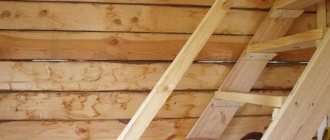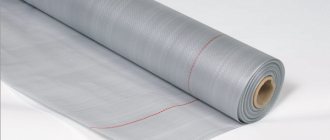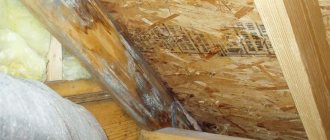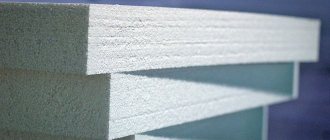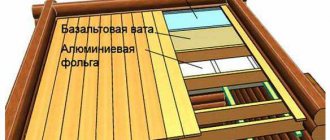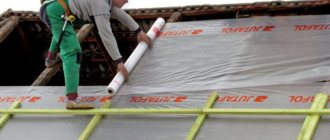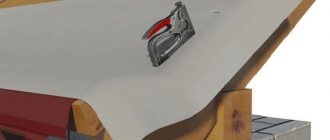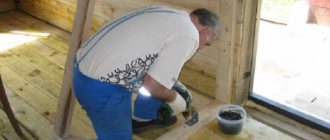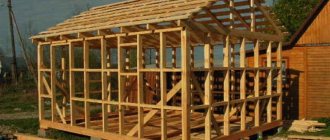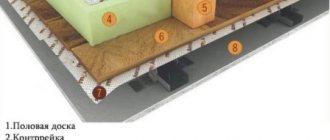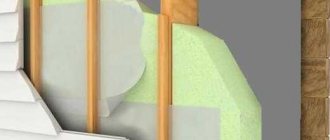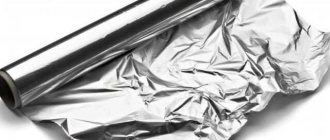Features of ceiling vapor barrier
Regardless of whether a Russian bathhouse is equipped with a steam room equipped with a wood-burning stove, or a sauna with a firebox using electric heating elements, a high level of humidity and heat will be constantly maintained in the room. To effectively retain heat over a long period of time, such rooms are equipped with thermal insulation. Another question is when the bathhouse is built from logs without special insulation. In this case, the vapor barrier layer must be installed exclusively on the ceiling.
However, there are also some nuances here. The need to equip a vapor barrier layer in a bathhouse appears in a situation where mineral wool is used. In a dry state, this structure is endowed with increased thermal insulation properties, which will significantly decrease when wet. When using foam plastic or penoplex, a vapor barrier layer is not equipped.
There are several main types of suitable vapor barrier materials available for sale when equipping a bathhouse:
- Film. This is the simplest type of vapor barrier layer, which is a dense canvas of white or blue colors. Depending on the brand, the material may be smooth or slightly rough. More expensive models use reinforcement that can look like a cage;
- Membranes are non-woven materials that provide sufficiently high-quality protection of insulation from condensation and steam;
- Foil. This is the most optimal vapor barrier material for bathhouse equipment, since it retains thermal energy quite effectively due to its coating.
The need to use a vapor barrier
A bathhouse is a building with elevated temperatures and humidity, which in most cases leads to the formation of condensation. To ensure proper removal of excess moisture from the premises, as well as to protect the roof and wall structures from deformation and destruction, a vapor barrier is provided for the bathhouse.
Insulation is applied to the entire structure - basement, foundation, interior and roof. Often, mineral or basalt wool is used as an insulating layer in a bathhouse. Such materials are resistant to rotting and deformation, accumulate heat well, and have a low cost.
If sheets of polystyrene foam, polystyrene foam or rolled polystyrene foam are used for insulation, then there is no need for additional vapor barrier installation.
Vapor barrier is used to protect against moisture and steam in the following cases:
- When excess moisture and hot steam from the steam room can penetrate into other functional rooms of the bathhouse or outside.
- When moisture is formed as a result of sudden changes in temperature conditions in the steam room, attic and other rooms, which leads to the appearance of condensation even before the stove begins to warm up.
To choose the right vapor barrier, it is recommended to take into account the purpose and design features of the premises:
- For the steam room, foil materials are used to reflect and accumulate heat.
- Film vapor barriers are used for washing.
- Membrane insulation or kraft paper is chosen for the rest room and dressing room.
Common types of vapor barrier
Common materials that have been commonly used over the years include plain kraft paper and polyethylene.
First of all, the choice of a suitable vapor barrier layer is determined by its location. An ordinary budget film is suitable for walls, which properly copes with the tasks of retaining heat and possibly protecting the insulation from getting wet. Polyethylene is absolutely moisture resistant and reduces the time required to raise the temperature in the steam room.
This is the most accessible method, but has certain disadvantages. Polyethylene film quickly loses its quality characteristics and gradually begins to deteriorate under the influence of high temperature, which is constantly maintained in the steam room.
It is preferable to use such material on walls, in the dressing room or where there is a place for relaxation. However, there is also a peculiarity here. Before purchasing a film, you must check it, fold it and carefully examine the visible seam. If such a seam is present, then the film will deteriorate very quickly. It is desirable that the material still remains as smooth as possible after folding.
Polypropylene film is considered a more modern and durable replacement for polyethylene. The material resists the effects of thermal energy much better, tears less and almost does not crack. The properties of the film do not deteriorate under the influence of high temperature or sunlight, so polypropylene is often used to equip the outer layer that protects the bathhouse from the wind.
The cost of such material is much higher than polyethylene. Cellulose or viscose is used as the basis for film production. It is not difficult to recognize such a material; the rough surface of polypropylene looks like matte. In this situation, it is necessary to equip a ventilation gap; I will equip a frame made of ordinary two-centimeter wooden slats under the front covering.
Kraft paper is a highly durable paperboard that is often used in construction. The structure of the material allows it to retain steam and protects the insulation. It is better to use such a vapor barrier for a rest room. If you make a vapor barrier in a steam room from kraf paper, the material will simply fall apart over time.
Often roofing felt or special glassine is used as a vapor barrier. Often such material is chosen in the absence of the opportunity to use something better. In theory, the products are capable of providing vapor barrier, since they have a high service life and moisture resistance. However, at elevated temperatures, glassine or roofing felt can release toxins and unpleasant odors.
Baths, saunas and swimming pools
1 vote
+
Vote for!
—
Vote against!
Until recently, bathhouses were built from a simple log frame with moss insulation. There was no talk of any thermos effect at that time. But technology is developing, and now the era of building energy-efficient baths and saunas has begun. The use of high-quality insulation and vapor barrier films allows you to warm up the steam room in a faster time and maintain high temperatures there for much longer. The article will discuss how to make a vapor barrier for walls, ceilings and floors in a bathhouse with your own hands.
Does a bathhouse need a vapor barrier?
- Regardless of whether a Russian bathhouse with a steam room is built, in which a wood-burning stove is installed or a sauna with an electric firebox, there will always be high humidity and temperature in such a room. To ensure high-quality heat retention for a long time, such rooms are equipped with a layer of thermal insulation. It’s another matter if the bathhouse is a classic one made of logs without any insulation. Then the vapor barrier is done only on the ceiling.
- But even here there are some moments. The need to vapor barrier the walls in the bathhouse arises only if mineral wool is used. In a dry state, it has high thermal insulation characteristics, which sharply decrease when wet. When using penoplex or polystyrene foam, a vapor barrier layer is not created.
Vapor barrier for frame bath
There are several types of vapor barrier materials available for sale that are suitable for use in the construction of a bathhouse.
- Films. This is the simplest type of vapor barrier, consisting of dense sheets of white or blue color. Depending on the manufacturer, its surface may be rough or smooth to the touch. More expensive models have reinforcement that looks like a cage.
- Membranes . They are non-woven materials that effectively protect the insulation layer from moisture and condensation.
- Foil. This is the most suitable vapor barrier material for a steam room, as it retains heat very effectively thanks to a special coating made of metallized lavsan or foil.
Traditional types of vapor barrier for baths
Traditional materials that were actively used several years ago include polyethylene film and kraft paper.
- First of all, the choice of vapor barrier depends on where exactly it is planned to be located. So, for walls you can buy the cheapest film , which effectively copes with the tasks of retaining heat and protecting the insulation from getting wet. Polyethylene is completely moisture resistant and reduces the time required for the required temperature heating of the steam room. This is the cheapest method, but it has significant disadvantages. Polyethylene film very quickly loses its properties and begins to deteriorate from high temperatures, which are often kept in the steam room. It is best to use it for walls in the dressing room or rest room, where it is customary to relax after the steam room. But here too there is a peculiarity. Before buying a film, you need to check it, fold it and look at the seam formed. If it is, then such material is unsuitable, since it will begin to deteriorate most quickly. Ideally, it should remain smooth after folding.
- A more modern and durable analogue is polypropylene film . It withstands high temperatures much better, and is much less likely to crack or tear. Their properties do not decrease under the influence of heat and ultraviolet radiation, and therefore polypropylene film is sometimes used as an external wind barrier for a bathhouse. Moreover, its price is not significantly higher than its polyethylene counterpart. Today it is produced on a cellulose or viscose basis. It is not difficult to see this layer, since the coating becomes rough to the touch and matte in appearance. Such high porosity allows you to retain a lot of moisture when using a steam room, and later it simply evaporates from the surface without penetrating the insulation layer. But in this case, it is necessary to arrange a ventilation gap, making a frame of wooden slats 2-3 cm thick under the cladding.
- Kraft paper, at its core, is a special construction cardboard characterized by its high density, which is responsible for the effect of retaining steam, preventing it from penetrating to the insulation. It should not be used for a steam room, but for a relaxation room it is a completely acceptable option. But only if it does not have a shower or swimming pool. Otherwise, it will get wet and simply fall apart, as a result of which it will need to be completely replaced with the dismantling of the facing covering.
- felt or glassine was used as a vapor barrier . This is rather due to the lack of choice of another material more suitable for these purposes. Theoretically, they are capable of coping with the task of vapor barrier of walls, as they have excellent moisture-resistant qualities and are durable. But when heated, they release a pungent odor and toxic substances that are harmful to health.
Modern types of vapor barrier for baths
Today, the construction market offers a number of modern, highly effective materials recommended by professionals.
Membrane vapor barrier
- This is one of the newest and most popular materials for vapor barrier of walls and ceilings in a bathhouse. Its uniqueness lies in the presence of two sides, one of which reliably protects the insulation from steam, and the other remains “breathable”. Double-sided or one-sided diffusion membranes, or as they are also called “breathable” membranes, are available for sale. Therefore, when purchasing and installing, you must immediately clearly determine which side to mount them correctly.
- It is also divided into several types according to the number of layers available: multi-layer and single-layer. The former are able to accumulate moisture inside themselves, and when the steam room cools down, they gradually release it.
- The most modern type of membrane vapor barrier is called “intelligent”. This is due to its versatility, which includes the ability not only to regulate humidity, but also to retain heat, and also act as a full-fledged waterproofing layer. Their price is very high compared to a simple membrane, but considering how many materials one fabric replaces, while saving space and labor hours, its use becomes justified.
Tip: the manufacturer always indicates exactly how to lay the membrane material. But if the packaging is lost, then first you need to determine the smooth and rough sides. It is the high porosity, which has absorbent qualities, that ensures the absorption and retention of excess moisture with its further evaporation. Therefore, this side should be made outward, facing the steam room. But the side with a smooth surface is attached close to the insulation. This applies to one-sided membranes; if the material is double-sided, then it can be mounted in any way, since it functions equally in both directions.
Foil vapor barrier for a bath
This is a whole range of materials created specifically for vapor barrier in steam rooms. All of them can withstand frequent temperature changes and heating up to 120°C without losing their properties. Their distinctive feature is the foil side, which effectively protects the insulation from the penetration of hot steam into it, while at the same time reflecting infrared radiation, allowing the steam room to warm up faster and not cool down longer. This is where its second name comes from – “reflective”.
- Foil vapor barrier on kraft paper . It has advantages only over plain foil, as it is more durable and easier to use. But the high hygroscopicity of the base, and, as a consequence, low resistance to soaking, makes it not very popular. Such features threaten not only rapid unsuitability for use, but also the risk of mold formation in it. The main producers are the Russian companies RufIzol and Alumkraft.
- Lavsan coating on kraft paper . Manufacturers claim that this material is suitable for use in rooms heated to 140°C. Despite the fact that this is more than enough for use in steam rooms, builders do not often use it. This is due to the unnaturalness of the material and its chemical origin. After all, for such premises it is customary to choose everything that is most environmentally friendly and safe. You can buy such a product from the Izospan companies under the FB and Megaflex KF labels.
- Foil vapor barrier on a fiberglass base . This is one of the most expensive materials. Thanks to a very durable and rot-resistant base, it will last for several decades even with the most active use of the steam room. In addition, it has good thermal insulation qualities. It is produced by companies such as Aromofol, Termofol and Folgoizol.
- Thermal insulation with foil . This material immediately contains a layer of insulation and a foil vapor barrier side. Mineral wool or isolon are most often used as thermal insulation. This also saves time on construction work. These products are produced by Rockwool, Ursa and Izover.
Coating vapor barrier for baths
- At its core, it is liquid rubber. It can also be used as a vapor barrier in a steam room. It contains various polymers, which, when completely dry, create a waterproof film that is highly durable and completely protects the insulation from steam. In addition, it has sound and heat insulating qualities. It is applied in liquid form with a brush.
- Such liquid compositions are recommended for vapor barrier of bath floors. The composition is suitable both for treating concrete surfaces and for application to wooden logs. If liquid rubber is chosen for protection against steam, then the consumption will be no more than 1.5 kg/m2, but for high-quality waterproofing you will need to spend about 3.5 kg/m2 (in the final result, the layer thickness should be about 7-8 mm).
- This is an excellent choice for brick baths or for use in the shower area of a recreation room. For a steam room, the coating vapor barrier should be selected especially carefully, taking into account the absence of toxic substances in the composition and the ability to withstand high temperatures.
Vapor barrier Izospan for baths
Undoubtedly, one of the leading manufacturers is the Izospan company. Their products have long proven themselves to be of the best quality, and the price remains affordable. This Russian company has been operating for more than 15 years, during which it has established the production of a whole range of vapor barrier materials.
- Izospan FB . This is one of the most popular materials for vapor barrier of bath walls. Durable kraft paper is used as a base with a foil layer of lavsan applied to it. Its characteristics allow use in rooms where temperatures rise above 100 °C. Thanks to the metallized layer, it simultaneously protects against moisture and reflects thermal radiation back into the steam room, preventing it from escaping through the walls. It is also recommended for vapor barrier of the roof in the bathhouse. This also effectively prevents heat from leaking through the roof and causing the steam room to cool down too quickly. This product has all the necessary certificates confirming its environmental friendliness and safety for humans.
- Izospan FX . The basis is foamed polyethylene with a thickness of 2 to 5 mm. On top it has a metallized coating. This material is considered universal and is suitable for steam, heat and waterproofing.
- Izospan FS . This is a polypropylene membrane fabric with a metallized layer on one side. It will also perfectly protect the insulation and structural elements of the bathhouse from steam and moisture. In addition, by reflecting heat, it will make heating the steam room more efficient and faster.
Proper vapor barrier of a bathhouse ceiling
Having decided on the material that will be used to vapor barrier the ceiling in the bathhouse, you can begin to work.
If you look at the ceiling pie from the bottom up, its design will look like this:
- finishing material, the most popular for these purposes is lining of deciduous trees, which does not emit resin;
- lathing made of wooden slats for fixing the lining. In addition, it acts as a gap for ventilation;
- vapor barrier layer. It is attached over the entire surface of the ceiling in monolithic layers, extending onto the walls by 15-20 cm. The strips of material will have joints between each other; they must be overlapped by 10 cm and glued with metallized tape. It is important here to make everything hermetically sealed, otherwise steam will seep out even through a small gap;
- Next comes the bathhouse ceiling itself, which is most often made of wooden logs and covered with boards. A vapor barrier film is attached to the bottom, and insulation is attached to the top;
- Basalt wool in the form of slabs or rolls is most often chosen as insulation for a bathhouse ceiling. The standard thickness is 5 cm, but the density may vary. In any case, for high-quality thermal insulation, you should make a layer of at least 10 cm and place the mats in a checkerboard pattern so that the next layer covers the sound of the first. For seamless insulation, you can use ecowool or expanded clay. A more economical thermal insulation material that is still used today is sawdust. But their use is also impractical without vapor barrier;
- It is advisable to make a windproof membrane on top of the insulation, which on the bottom side can release steam that accidentally gets there from the insulation, and on the top will protect from possible moisture;
- The finishing layer of the attic will depend on the function of the room. If it is a residential attic, then a finished floor covering is laid; if it is an unused attic, then the insulation is simply covered with something to protect the thermal insulation from mechanical damage.
When the second floor of the bathhouse is in use, then in addition to the correct arrangement of the interfloor ceiling, care must also be taken about the vapor barrier of the bathhouse roof.
Advice: if the bathhouse has a high-quality vapor barrier, then after using the steam room you must open the door to thoroughly check it.
Hydro and vapor barrier of bath walls
Most often, during construction, heat and vapor barrier work is carried out simultaneously. That is, having laid the thermal insulation material, a vapor barrier film is immediately pulled over it. This is the most effective and efficient and does not take much time.
It’s another matter when repair work is carried out in an already in use bathhouse. In this case, it is necessary to dismantle all the wooden paneling so that it can be reused in the future. Unscrew the sheathing and attach a vapor barrier to the cleaned walls.
Stages of work
- The walls should already be insulated. This means that wooden frame slats are attached between the mineral wool mats at 60 cm intervals.
- The work is carried out from the corner, attaching the edge of the vapor barrier film with an overlap of 10 cm onto the adjacent wall. First, fix it with a construction stapler in several places. This must be done quite firmly so that in the future you can tighten it with tension.
- The foil heat-reflecting side is located inside the steam room, and the foam base is close to the heat-insulating material.
- First, stretch the bottom row along the length of the entire wall, firmly fastening it with a stapler to each vertical guide of the frame. As a rule, the width of the roll is 1.5, therefore, there will be a longitudinal joint in the middle of the wall. Its overlap should not be less than 10 cm; for greater tightness it is glued with metallized tape.
- When the vapor barrier material is applied to all the walls of the bathhouse, slats for the finishing finishing material are attached on top. They are mounted directly on the guides of the frame made for insulation. This will allow you to immediately secure the film more firmly and prepare the base for the lining.
Vapor barrier of the floor in the bathhouse
It all depends on how the bathhouse was built. Most often it is customary to install a simple wooden floor with a hole for water drainage. But in this case, the heat quickly leaves the steam room, as a result of which it quickly cools down, and only the first visitors have time to really steam. To avoid this, modern bathhouses have floors with several layers.
- The first layer is a regular wooden floor, with a drain provided for water drainage. The boards are treated with liquid coating waterproofing.
- A heat-insulating material, for example, basalt wool, is laid on top.
- A vapor barrier on a non-rotting base is laid on it.
- Next, install a concrete screed of sufficient thickness for subsequent laying of the tiles. At all stages, one must not forget about arranging a ladder for draining water after dousing. Therefore, the floor should have a slight slope so that the water drains without stopping.
- When the screed is completed and the tiles are laid, the floor is ready. All that remains is to lay wooden gratings on top, and the warm and durable floor in the bathhouse is ready.
Installation Tips
Ceiling vapor barrier is carried out from the inside of the room. As an exception, areas in which the air temperature reaches -32 degrees in winter are considered. In such climate conditions, vapor barrier must be installed on both sides.
The method of installing a vapor barrier layer is determined by the properties of its surface on which the material is fixed. You will definitely have to follow certain tips:
- Before installing a vapor barrier layer on the ceiling, the entire surface is carefully sealed. Joints and areas adjacent to chimneys and ventilation elements must be treated.
- The vapor barrier is placed between the insulation and the steam room.
- The layer should cover the entire area of the ceiling without the slightest cracks or gaps.
- The fixed material does not require sagging, but it also cannot be stretched so much because a rupture may form as a result of changes.
- During the installation process, the vapor barrier material is laid with an overlap of 10 cm. It is unacceptable to leave joints in the corners. Only solid sheets are used there to ensure that the overlap is of the highest quality.
- An allowance around the perimeter of at least 20 cm will be required.
- Before installation, the ceiling surface is effectively cleaned of dust and dirt, and then properly dried.
Before installing all materials, you must thoroughly familiarize yourself with its main features and take into account the advice of qualified specialists in this field.
The most common materials for vapor barrier of a bath
Modern vapor barrier technology for a bathhouse is carried out using both “old-fashioned” methods and the latest technologies. This is facilitated by the appearance of high-tech materials on the building materials market and the addition of new layers to the “classical” heat and vapor barrier. For example, reflective insulation in the form of aluminum foil or “breathable” impregnated glassine.
The construction market is replete with offers in the niche of materials for arranging vapor barriers. Among them, Izospan, Armitex, Penoplex are gaining popularity. Conventional polyethylene film is being replaced with specialized membranes, but obsolete roofing felt and roofing felt are still used in country house construction.
It is undesirable to use similar old-style materials in a steam bath - they contain resins that release formaldehyde when heated with steam. It is preferable to use glassine only in the dressing room due to its minimal ability to reflect moisture from the surface of the walls.
Companies involved in the construction of sanitary facilities and other structures of similar functionality do not skimp on materials. When building a country bathhouse yourself, you have to choose practical and affordable materials yourself. Primary requirements:
- counteracting the combustion process;
- environmental friendliness;
- reliability in operation;
- resistance to rotting and decomposition;
- heat resistance;
- moisture resistance.
Clay or a mixture of fatty clay with sawdust is used less and less today, but it is the most accessible, proven over the years, eco-material. Although sawdust itself is flammable, it makes the coating mixture more resistant to cracking. For walls, a layer of 2 cm is enough. The main property of clay is that it “breathes,” that is, it absorbs excess moisture and then releases it when it dries. And the heat only makes it harder.
They even built temples on this property in Vietnam - they coated bales with straw on the outside with clay and burned them from the inside. These temples still stand today.
Foil materials
Aluminum foil is used for sheathing unprotected surfaces and porous thermal insulation. Known for its maximum ability to reflect heat into the steam room and repel moisture from the surface of the walls. It does not react to high temperatures, has no toxic fumes, does not deform, and is resistant to mechanical stress.
Like any metal, when it cools suddenly, the foil forms condensation, so it is not recommended to open the doors suddenly in frosty weather with excess humidity. If this is a multi-layer vapor barrier system for a steam room, and the room itself has sufficient insulation and air conditioning, then these manifestations should not occur.
Foil material gives better insulation performance in combination with full multi-layer insulation and an air gap between it and the reflective layer. Insulation with sheets of aluminum foil is done overlapping, the lower edge is brought to the floor, and the joints are treated with special tape for foil insulation.
Might be interesting
Vapor barrier
Effective and simple solutions for insulating ceilings in…
Vapor barrier
Technologies and materials for effective thermal insulation of floors in…
Vapor barrier
Vapor barrier and waterproofing, is there a difference?
Vapor barrier
Features of vapor barrier of a wooden building
The latest generation of 3-in-1 multilayer materials used for complete insulation are often equipped with a foil coating. They combine several functions:
- thermal protection;
- vapor barrier;
- the ability to reflect heat into the room (does not allow thermal and infrared radiation to pass through).
Film materials
Film vapor barrier or protective membrane is quite reliable. Like any other film, it gives a deceptive impression, but it is resistant to tearing and is not subject to deformation during operation. It makes it easy to protect multi-layer insulation from warm steam.
It is used indoors on top of porous materials, covering the surface of an insulated ceiling or walls. But if the membrane joints are not connected tightly enough or a hole is made during installation, then its vapor barrier properties will be minimized.
The easiest way is to attach the film to the slats of the wooden ceiling sheathing on top of the mineral wool (another insulation between the beams) with the staples of a construction stapler. The fabrics are not pulled very tightly, leaving minimal sagging; the sides of the membrane are attached with an overlap. The seams of the film strips are fixed with special tape.
Membrane materials
The most reliable vapor barrier membrane is multilayer with mesh reinforcement. Reinforcement protects film materials from deformation due to temperature changes, which is why such membranes are the most durable.
Do not stretch membrane materials so that they may respond to temperature fluctuations by expanding or expanding slightly. Under heavy load, improper installation and large temperature ranges, it gradually loses its elasticity - let it sag slightly between the slats.
Clay vapor barrier
The traditional method of vapor barrier of the ceiling is the treatment of cracks and joints with an ordinary solution of clay and sand, which can also be used for laying stoves. Effective vapor barrier characteristics are on par with modern materials.
The solution is equipped as follows:
- All debris and large fractions are removed from the sand using a sieve;
- Kiln clay is placed in water for three days and then passed through a sieve;
- The components are combined in equal proportions and stirred until smooth. If necessary, add a small amount of water.
Laying a vapor barrier on the roof of a bathhouse
To ensure normal vapor barrier in a bathhouse, you need to install it not only on the walls and ceiling, but also on the roof. To do this, a vapor barrier membrane is laid on a wooden frame in the attic, and insulation and waterproofing are placed on top. And already on it the counter-lattice is installed, followed by fastening of the roofing material.
In the article above, we looked in detail at how to make a vapor barrier in a bathhouse. You need to clearly understand the difference between vapor barrier and waterproofing, understand their characteristics, so that after all the work is completed, unforeseen nuances do not arise. If everything is done correctly, the finished bath will last a very long time.
Methods of vapor barrier of a bathhouse ceiling
Next, you need to consider the process of installing a vapor barrier and recommendations from professionals on how to properly equip the ceiling. First you need to take into account the type of roof, more specifically, the absence or presence of an attic space. In a situation where an attic or attic is installed in such rooms, the ceiling will be much worse at transmitting air filled with moisture, but this does not mean that there is no need to install a vapor barrier layer.
Often, similar materials are used to insulate a room with an attic, but it is advisable to treat the board on the roof side with a clay mixture. Determining the most effective vapor barrier material for a bathhouse is not so easy.
Be sure to familiarize yourself with the most effective methods:
- Boards with a minimum thickness of 2 cm are laid on the wooden ceiling. A vapor barrier layer made of foil or cardboard treated with drying oil is mounted on the board.
- After this, the cracks between the boards are covered with clay-sand mortar.
- Then insulation made of expanded clay, ordinary mineral wool or polypropylene is applied.
- The boardwalk rests on top of the insulation.
Second way:
- The board is placed on square beams.
- To make the surface sufficiently moisture resistant, you need to pre-treat the boards with a drying oil solution.
- On the upper side, boards are laid on the ceiling beams, the gaps between which are also processed.
- Then the board surface is covered with a vapor barrier layer.
- As thermal insulation, a little sand is poured onto the vapor barrier. Today there are many other higher quality materials for providing thermal insulation that can also be used.
For expanded clay or mineral wool, polyethylene film is suitable as a vapor barrier material. One of the most significant steps before installing a vapor barrier for the ceiling in a bathhouse is antiseptic treatment. This procedure allows you to get rid of possible difficulties associated with dampness in the future. When choosing an insulating layer, you can give preference to expensive substances, as well as fairly effective improvised means such as clay or dry earth.
What is it for?
The main purpose of this structural element of the ceiling cake is to protect its remaining elements from getting wet.
Everything seems to be clear. However, a logical question arises: is it needed in the entire bathhouse or can it be limited to the rooms that are the most humid - the steam room and the washing room?
The answer to this is simple: no, you cannot limit yourself to a steam room and a washing room, because vapor barrier is part of the standard ceiling pie, regardless of the room in which it is being built. Why is that?
Because the main element that needs protection is
the thermal insulation material , which lies at a higher level.
Since in most cases this is mineral wool, the mats of which are most affordable and easy to install, one must also take into account the property of this material, such as sensitivity to the accumulation of condensate in its thickness. The fact is that moisture accumulating between the fibers of stone wool significantly reduces its thermal insulation properties. After all, the main heat insulator is always air. We simply create a heat-resistant environment for it in the form of thin mineral wool fibers or clay partitions in expanded clay balls. Water, on the contrary, connects the fibers (this does not apply to expanded clay, the clay is baked there, and water does not get inside the balls), improving the conductivity of heat through this medium .
Condensation forms not only when the room is very humid, but also when there is a temperature difference between what is inside and what is outside.
And humidity is present in any room and outside it; it is a natural component of the air. CONCLUSION! Ceiling insulation is more a tribute to the properties of the heat insulator and wooden structures, which also do not tolerate moisture well, collapsing from it, rather than a characteristic feature of a bathhouse or specifically a steam room with a washing room.
In the Russian steam room
The above does not mean that a steam room or washing room does not need increased protection from moisture. Steam is water droplets heated and suspended in the air, rising upward towards the ceiling.
If you don't put an obstacle in place, they will go higher, settling on the colder parts of the structures. In terms of the amount of steam, the Russian steam room is second only to the Turkish hammam, but it is usually finished with tiles or mosaics, which makes it less sensitive. The Russian steam room is traditionally finished with wood, and if its surface layer, for example, lining, is inevitably sacrificed and takes on all the blows of increased temperature and humidity, then the inner layers can (and should) be protected.
We will talk about the methods of vapor barrier of the ceiling in a bathhouse a little lower, but for now it is important to draw conclusions - a Russian steam room clearly needs a well-thought-out and powerful vapor barrier. Does the same apply to the sauna?
In the sauna
It is not for nothing that the Finnish sauna is called “dry air”. In the orthodox version, the humidity in the sauna is minimal, amounting to no more than 5-15%. The Finns don’t pour much water on the stones, which is understandable - they either lay them out in a mound on top of the stove, or in a mesh covering the body, and this does not give the stones the heat needed to produce light, fine steam. Instead, the steam is thick and heavy.
In addition, the high temperatures of the Finnish steam room do not allow a person to easily absorb excess steam.
IMPORTANT! There is a rule - the higher the temperature, the less steam is needed for people to feel comfortable in the steam room. The reverse is also true.
The third essential property of a sauna is vigorous air exchange , which is achieved using natural or forced ventilation.
Let's summarize: the sauna has good ventilation and high temperature, both of which help eliminate excess moisture, so even the surface layer of the ceiling will not suffer much during the procedures. However, insulation of the ceiling is mandatory, which means you need to make sure that the insulation does not accumulate condensation even due to temperature differences. Therefore, it still needs to be insulated , except that the vapor barrier itself can be standard, but (since the temperature in the sauna is high) it must be designed for exposure to heat.
Proper waterproofing of the top of the insulation will also help, but more on that later.
When to install a vapor barrier
Vapor barrier of the ceiling in the bathhouse is considered the most significant procedure in comparison with other stages of steam room equipment. Everyone can understand that heat will always rise upward, closer to the ceiling. This is the main feature that requires attention when equipping a bath room. The ceiling in the bathhouse is equipped with protection against collecting vaporous liquid, which can have a destructive effect on building materials.
In addition, without a sufficiently effective vapor barrier, the constructed bathhouse will not properly perform the functions for which it was created. In the last few years, more advanced methods of vapor barrier equipment in the bathhouse have begun to be used. Since we live in the 21st century, when technological innovations appear everywhere, protection against the accumulation of condensation on the ceiling in the bathhouse is still provided by traditional methods.
Aluminum foil is deservedly considered the highest quality material, which allows you to create a unique thermos effect in the bathhouse. This is a great way to retain steam; in such a bathhouse your vacation will be truly unforgettable.
How to properly install a vapor barrier in a bathhouse
For the correct functioning of such material you need:
- seal seams and joints as efficiently as possible;
- provide a gap between the finishing and the foil.
Sealing
Absolute sealing of the insulation seams will most likely not be possible, but it is quite possible to significantly reduce the amount of steam that will enter the insulation. You will need to lay the foil vapor barrier for the bathhouse overlapping, about 5-10 cm.
The joints must be glued with either double-sided or foil tape. You can purchase it at any hardware store.
Insulation with bath foil must not be damaged. Where the film is secured with bars, holes will appear. To minimize them, you should use a construction stapler. To achieve maximum quality, you can go over the top with tape again at the fastening points.
There is another good method of fastening panels - using wooden clamping strips. Nails are driven into them every 15-20 cm. In this case, excellent protection against steam penetration is achieved.
Creating a gap to provide ventilation
The gap is provided during the process of covering the frame for finishing. It should exceed 2 cm. After the bars are selected, they are nailed on top of the vapor barrier. Next, the wooden lining is already attached. Again, remember that the foil must remain completely intact.
As a result, some of the steam that rises will fall out as condensation on the vapor barrier film. The droplets formed will immediately be dried by natural air currents passing in the space between the insulation and the lining. If the work is done correctly, rotting is out of the question.
Wall protection
Vapor barrier of bathhouse walls is one of the elements of the “pie” that is made during the construction of the building. It is laid on top of the thermal insulation on the street side. The vapor barrier is attached to the insulation using a stapler. An important point is that the protective material must be laid in excess. There should not be a situation where any part of the wall remains untreated. Therefore, it is not worth saving on protective materials when building baths.
Various materials can be used as a vapor barrier. A popular option is aluminum foil. It prevents steam from escaping, due to which heat is retained in the bathhouse for a long time; you can also use a special vapor barrier Izover Sauna. It is available in two versions - for indoor and outdoor installation.
Isover Sauna is not a simple vapor barrier. It also combines the function of insulation. Therefore, when choosing this material, you can save on the thermal insulation of the building. Material thickness – 100 mm for outdoor installation, 50 mm for indoor installation. Installation of this particular protective material is most practical. It was specially designed for installation in wet rooms. Therefore, it is the best option for installation in baths.
Is it necessary in other rooms?
Whether or not to make a vapor barrier in the remaining rooms of the bathhouse is your choice. But even in the locker room when using a bathhouse, the humidity level is always significantly higher than normal. If your bathhouse is built of wood and will not be insulated either from the inside or from the outside, then you can do without this layer - drying will occur due to the fact that the wood “breathes” and has the ability to remove vapors. But even in this case, it is already desirable to have a well-thought-out ventilation system in the bathhouse.
If the bathhouse is made of brick or foam block, then vapor barrier in all rooms is required. Moreover, when creating ventilation and insulation/steam/waterproofing, you must keep in mind that you will have to dry not only the insulation, but also the walls themselves due to the hygroscopicity of the material.
Schemes for vapor barrier of a brick bath
Therefore, in addition to the vapor barrier layer from the inside, a layer of wall waterproofing is required. The diagram shows two methods of insulating the walls of a brick bath, which necessarily include foil material, which plays the role of a vapor barrier and at the same time reduces heat loss.
You might be interested in “Insulating the walls of a bathhouse from the inside with your own hands.”
